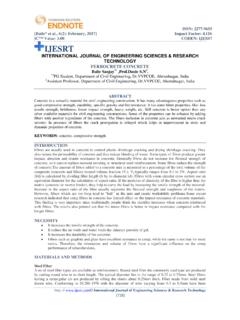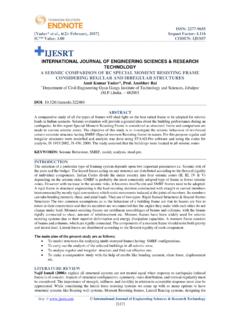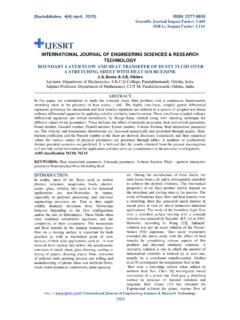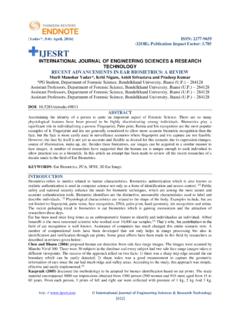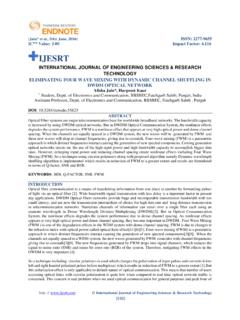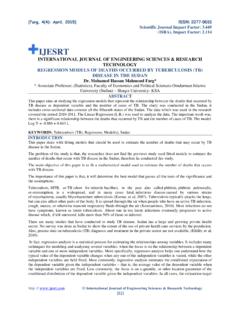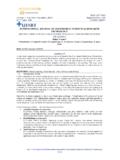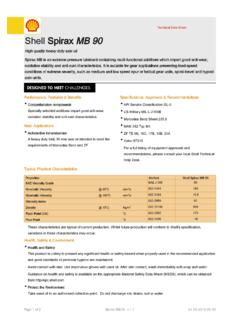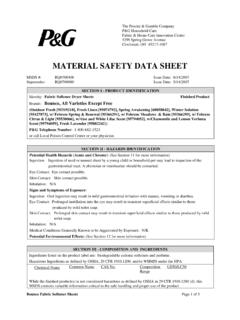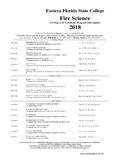Transcription of IJESRT
1 [Alain*, 5(4): April, 2016] ISSN: 2277-9655 (I2OR), Publication Impact Factor: http: // International Journal of Engineering Sciences & Research Technology [354] IJESRT INTERNATIONAL JOURNAL OF ENGINEERING SCIENCES & RESEARCH TECHNOLOGY STUDY OF THE VARIATIONS OF THE MACROSCOPIC ELECTRIC PARAMETERS OF A SOLAR CELL ACCORDING TO THE USE TEMPERATURE Alain K. EHEMBA, Demba DIALLO, Mouhamadou Mamour SOCE, Ousmane DIAGNE, Moustapha DIENG Laboratory of Semiconductors and Solar Energy, Physics Department, Faculty of Science and Technology University Cheikh Anta Diop Dakar - SENEGAL DOI: ABSTRACT The Research has for objective to increase the performances of the thin film solar cells.
2 Many scientific publications were interested by the development of the thin films which make the cell. Others based their research on the technology of the cell and the experimental elaboration conditions. In this paper we are interested by the performances of the cell during its utilization period. We study the influence of the use temperature on the macroscopic electric parameters of the solar cell. The range of use temperatures varies from 270K to 320K with a step of 10K. The type of cell studied is a Cu(In, Ga)Se2 thin film solar cell.
3 The elucidated physical parameters are the characteristic density of current-voltage J-V, the open circuit voltage Voc, the short circuit current density Jsc, the form factor FF and the cell efficiency . We find at the end of this investigation that the temperature of 270K gives the best electric parameters with a cell efficiency equal to 20,65%. These parameters decrease with the increase in the use temperature but remain significant. KEYWORDS: AMPS, use temperature, electric parameters, Cu(In,Ga)Se2 thin film, solar cell. INTRODUCTION The use of the thin films begins with a study from their elaboration techniques.
4 [1] This research was then directed towards the improvement of the performances of the cell by taking to account the physical properties of the layers which make the cell, the thickness of the layers, the technology of the cell, [2]-[3]. The use of the thin films in the technology of the solar cells is a well maitrized technique which does not stop improving in the course of time.[ 4]-[5]. The development of the use of CuInSe2 thin film solar cell and its derivatives should not be limited to the improvement of the experimental conditions such as the deposit voltage, the deposit temperature, the time of annealing and the thin layers thickness.
5 These already elucidated parameters made it possible to increase the performances of the solar cells.[6]-[8 ] Figure 1: Representative diagram of the type of cell studied. [Alain*, 5(4): April, 2016] ISSN: 2277-9655 (I2OR), Publication Impact Factor: http: // International Journal of Engineering Sciences & Research Technology [355] However we are interested by the extra experimental parameters. We study the effect of the use temperature of the cell on the macroscopic electric parameters. These parameters are the density of current-voltage characteristic, the open circuit voltage Voc, the short circuit current density Jsc, the form factor FF and the cell efficiency.
6 The use temperatures considered are 270K, 280K, 290K, 300K, 310K and 320K. Indeed we take to account the temperatures from 0 C to 50 C, the cells being exposed to the sun. We neglect the conditions of encapsulation of the cells, the optical transmission of glass, the slope of the cells and the shade phenomena. All the properties of the cells are taken into account. The solar cells which are the subject of our study are indicated by the Figure 1. The study of the macroscopic electric parameters passes by a perfect control of the equations which govern the physical phenomena which occur in the cell.
7 These equations allow us to deeply understand the physical phenomena which occur in the cell going from the absorption of the incidental solar photons to the creation of the current. MATERIALS AND METHODS To undertake our study, catches were not carried out in a photovoltaic field but we base our study on three sections. The first shutter consists in carrying out a simulation using the Analysis of Microphotoelectonics Structures AMPS. This last is a software developed by Fonash et is conceived for the simulation of the thin film solar cells. The layers of these structures can be single-crystal, polycrystalline, amorphous or even of the combinations.
8 [9]-[10] To carry out this simulation we use proven parameters of which certain are indicated by table 1. Table 1: Some physical parameters of the layers which constitute the studied cells Physical parameters Window layer ZnO Tampon layer CdS Absorber layer Cu(In, Ga)Se2 Thickness ( m) 3 Gap (eV) Permittivity 9 10 Density of donors Nd (cm-3) 1 1018 1 1018 --- Density of acceptors Na (cm-3) --- --- 2 1016 Each layer which constitutes the cell was studied in our preceding work already published. The second shutter of our work concerns the handling of the equations which govern the physical parameters which intervene in the heart of the solar cell.
9 These equations are the Poisson's equation, the equations of continuity and the transport equations. We had to develop these equations before.[11] This shutter enables us to see the convergence of the results obtained with simulation. The third shutter of our work concerns the tracing of the characteristics studied with Matlab. It is mathematical software which enables us to obtain the curves of variations of the characteristics studied according to the ambient temperature. The study is carried out under spectrum with an incidental power of sunning One takes into account the totality of radiation wavelengths which reach the window layer.
10 We start by studying the variation of the current density according to the voltage for use temperatures from 270K to 320K. This variation enables us to approach the study of the other macroscopic electric parameters like the open circuit voltage Voc, the short circuit current Jsc, the form factor FF and the efficiency . Subheading should be 10pt Times new Roman, justified. RESULTS AND DISCUSSION Effect of the use temperature on the current density-voltage characteristic. The Figure 2 gives us the variation of the density of current-voltage characteristic according to the temperature.
